Table of Contents
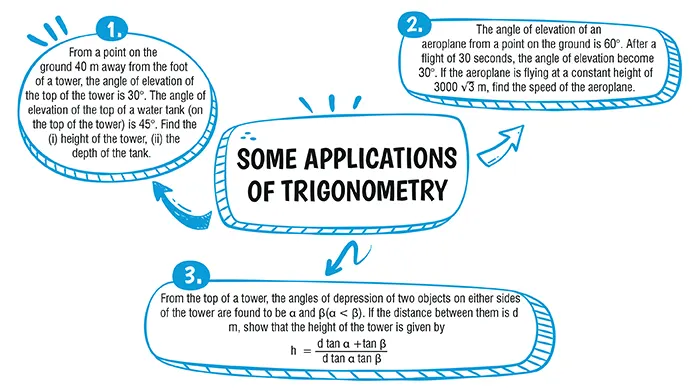
Ans.(c) 25
Explanation:
Let the height of the tower be H m.
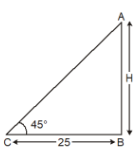
Ans. (c) 75 \sqrt{3}\\Explanation:
Let the distance of the car from the base of the tower be x m.
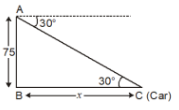
Height of tower = 75 m
\\ \text{tan 30}^o = \dfrac{\text{perpendicular}}{\text{base}}\\
⇒ \dfrac{1}{\sqrt{3}} = \dfrac{75}{x}\\
⇒ x = 75 \sqrt{3} \\
Thus, distance of the parked car from the
base of the tower is 25 \sqrt{3}
Ans.The height of the tower is h = 23.1 m and the depth of the tank is h= 16.9 m
Explanation:
Let BC be the tower of height h m and CD be the water tank of height h_1 m. Let A be a point on the ground at a distance of 40 m away from the foot B of the tower.
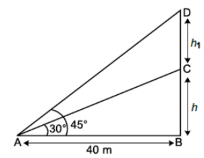
Ans. The speed of the airplane is 720 km/hr.
Explanation:
Let the ground distance between the airplane A and the point E be x m.
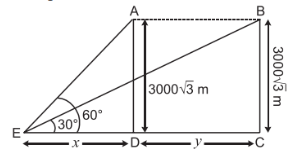
Given, height AD is 3000 \sqrt{3} \text{m } and the angle of elevation is 60°
So, in ∆AED,
\text{tan 60}^o = \dfrac{3000\sqrt{3}}{x} \\
⇒ \sqrt{3} = \dfrac{3000\sqrt{3}}{x}\\
\text{⇒ x = 3000 m }\\
Let the new distance (DC) covered by the airplane in 30 seconds be y m.
\\ \text{So, tan 30}^o = \dfrac{3000\sqrt{3}}{3000 + y} \\[4.5 bp]
⇒ \dfrac{1}{\sqrt{3}}= \dfrac{3000\sqrt{3}}{3000 + y}\\[4.5 bp]
⇒ 3000 + y = (3000\sqrt{3})\sqrt{3}\\[4.5 bp]
⇒ 3000 + y = 9000\\[4.5 bp]
\text{⇒ y = 9000 - 3000 = 6000 m}\\[4.5 bp]
Thus, distance covered in 30 seconds = 6000 m
\\ \text{Hence, Speed = } \dfrac{6000}{30} \\
\text{= 200 m/sec}\\
= 200 × \dfrac{18}{5}\text{km/hr.}\\
Hence, the speed of the airplane is 720 km/hr.
Explanation:
Let AD be the tower and B, C be the two objects on either side of AD.
Given, BC = d = BD + DC and AD = h
\\\text{In ∆ADB, tan α = } \dfrac{AD}{BD} \\
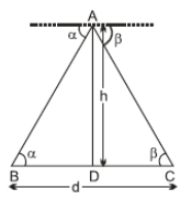
| Chapter No. | Chapter Name |
|---|---|
| Chapter 1 | Real Numbers |
| Chapter 2 | Polynomials |
| Chapter 3 | Pair of Linear Equations in Two Variable |
| Chapter 4 | Quadratic Equations |
| Chapter 5 | Arithmetic Progressions |
| Chapter 6 | Triangles |
| Chapter 7 | Coordinate Geometry |
| Chapter 8 | Introduction to Trigonometry |
| Chapter 9 | Some Applications of Trigonometry |
| Chapter 10 | Circles |
| Chapter 11 | Areas Related to Circle |
| Chapter 12 | Surface Areas and Volumes |
| Chapter 13 | Statistics |
| Chapter 14 | Probability |
| Chapter Wise Important Questions for CBSE Board Class 10 Maths |
|---|
| Real Numbers |
| Polynomials |
| Pair of Linear Equations in Two Variables |
| Quadratic Equations |
| Arithmetic Progressions |
| Triangles |
| Coordinate Geometry |
| Introduction to Trigonometry |
| Some Applications of Trigonometry |
| Circles |
| Areas Related to Circles |
| Surface Areas and Volumes |
| Statistics |
| Probability |
CBSE Important Questions Class 10
ICSE Important Questions Class 10
CBSE Important Questions Class 10
ICSE Important Questions Class 10